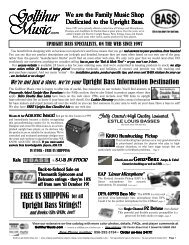MAKE FRIENDS WITH YOUR AMP - Gollihur Music
MAKE FRIENDS WITH YOUR AMP - Gollihur Music
MAKE FRIENDS WITH YOUR AMP - Gollihur Music
Create successful ePaper yourself
Turn your PDF publications into a flip-book with our unique Google optimized e-Paper software.
P age | 8<br />
High Pass Filter – aka Low (Bass, Sub-Bass) Cut Filter, Subsonic Filter, Depth Control – The counterintuitively<br />
named “High Pass” Filter is so-called because it lets high frequencies pass. And, like the<br />
black knight, it stops undesirables (in this case, boomy and muddy low frequencies) from passing,<br />
starting at the frequency where you adjust the knob or slider. This feature is a popular and very<br />
useful one, particularly for upright bass players, as it can get rid of low frequency rumble, and kill<br />
tone-robbing subsonic sounds beneath the range of notes your bass can play.<br />
While we know a low E is 41.2Hz and a low B is 30Hz, it’s best to set this control by ear, because it isn’t a sharp<br />
cutoff but gradual reduction at the frequency you select. Using this control<br />
properly can reduce “mud” and power-robbing, bass vibrating lows that<br />
make your sound flabby, and encourage feedback. That satisfying thickness<br />
on stage may mean your audience is just hearing rumble, and while that rich<br />
maple syrup may taste good, it’s no fun to swim in it. Whether you need to<br />
use one — and where you’d set it — will depend on your instrument and pickup, as well as the stage and setup (for<br />
instance, whether you’re stuck in a corner).<br />
Want to know more? Check out our FAQ about High-Pass Filters.<br />
Enhance, Shape, Contour… These are a sample of labels you’ll find on some amp knobs, most of which change the<br />
tonal character of your signal by boosting high and low frequencies and cutting the midrange. In my experience they<br />
seldom help the sound of upright bass — which in my opinion needs those midrange frequencies to help define its<br />
character in a live performance mix — and they often impart an “electric bass” or otherwise generic tone. Switches<br />
or buttons like Deep, Bright, etc. will also apply a specific tone shape, which can also be kind of radical for upright.<br />
Learn these tools by setting all of the amp’s tone controls at neutral, and try each of them using the techniques<br />
discussed in the beginning of this e-Guide.<br />
A FEW OTHER RELATED TOOLS<br />
These last few common amp features are not specifically involved in tone, but it’s good to know what they do:<br />
Phase Switch: When a signal is “in phase”, a note you play pushes sound waves (we’ll visualize it as “air” for the<br />
sake of easy comprehension) from your bass into the room, and the vibration of your amp’s speaker also pushes<br />
similar “air” out into the room. A Phase Switch (also called a “Phase Reverse”, “Invert Switch,” etc.) reverses the<br />
signal’s phase, so when you play a note, the speaker more or less pushes air “in” while your bass is pushing out (and<br />
vice-versa). Reversing phase may or may not result in a big change to your sound. But since it is the opposite from<br />
your bass’ vibrations, it doesn’t “couple” with the bass and make your bass vibrate more. In practical use, the use of<br />
reverse phase may help you gain a little more volume before you get feedback, but don’t expect a miracle.<br />
Another use for a phase switch is when one is using two pickups, or a microphone with a pickup. Different devices can<br />
be inadvertently wired in or out of phase, and if the phase is not the same it will usually rob you of bass response or<br />
balanced tone. If you suspect this condition, switch the phase on one channel and listen to the result. The Euphonic<br />
Audio Doubler has a Phase Knob, which changes phase gradually from one extreme to the other, for more precise<br />
adjustments.<br />
Active noise-cancelling headphones use this principle of phase reversal by reproducing<br />
what they “hear” (on built-in microphones) in reverse phase, thus effectively “cancelling”<br />
the sound in your headset.<br />
Make Friends With Your Amp – by Bob <strong>Gollihur</strong><br />
Courtesy of <strong>Gollihur</strong> <strong>Music</strong> • www.<strong>Gollihur</strong><strong>Music</strong>.com • ALL MATERIAL ©COPYRIGHT 2012 BOB GOLLIHUR




